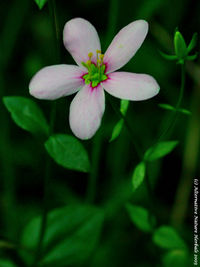Centaurium Erythraea
| See Also | Botanical Monographs |
|---|
Centaurium erythraea is a bi-annual herbaceous plant with basal rosette of leaves and clusters of 5-petaled pink flowers. The stem is erect and square reaching up to 12 inches with much branching out at the top. The leaves are shiny and light green. There are many species of Centaurium and others in the Gentianaceae family that are easily mistaken for this species. [1] To explore the characteristics, medicinal uses and prescribing considerations of this herb in more detail, check out the references indicated. [2], [3]
Contents
Characteristics
- Common Names: Centaury, Red centaury, Common centaury
- Family: Gentianaceae
- Habitat: Centaurium erythraea is native to central Europe and North Africa but has also been introduced elsewhere. It prefers dry slops, woodlands, roadsides, and grassy places in groups.
- Parts Used: Aerial parts (stems are the most bitter, flowers are intermediate, leaves are the least bitter)
- Constituents: glycoside bitter, secoiridoids, alkaloids, xanthone derivatives, phenolic acids, triterpenes, oleanolic acid, resins.
- Medicinal Actions: Bitter tonic (detectable at 1:3500 dilution), stomachic, sialagogue, cholagogue and choleretic (increases gastric motility), hepatic, carminative, galactagogue, stimulates the sympathetic nervous system; promotes circulation
Uses
Historical Uses:
Centaurium Erythraea is believed to have been used by the centaur Chiron for an arrow wound. It is also considered lucky by the Celts and is included as an ingredient in vermouth. It has been used, historically, for fevers.
Medicinal Uses:
- Centaurium is an appetite stimulant and is used as a treatment for anorexia.
- It is also used for digestive problems such as dyspepsia, constipation, flatulence and heartburn. The bitter action stimulates the entire digestive reflex allowing for optimal absorption and uptake of nutrients.
- Centaury has been used in formulas for this action to increase iron uptake in those with anemia.
- Since phenolic groups act as free-radical scavengers and bind to heavy metals, the antioxidant activity of Centaury was studied using an infusion from the flowers. The conclusion was that the phenolic compounds either scavenged the superoxide radicals or noncompetively inhibited xanthine oxidase.[4]
Prescribing Considerations
The herb should be taken over several weeks for best effect and should be sipped slowly.[5]
The information provided is intended to augment the treatment from a naturopathic doctor or other trained medical professional. Although most herbs are generally safe, it is recommended that you avoid self-prescribing especially when there is an underlying ongoing medical condition, if you are on any prescription medications or if you are pregnant or breastfeeding.
Formulations and Preparations
Safety
The safety and prescribing considerations for Centaury include: [6], [7]
- Centaury is listed on the FDA's GRAS (Generally Recognized As Safe) list as a flavoring.
- Side Effects: Can cause nausea in higher doses, depending on the person's sensitivity to the taste. This is why some sources say to "sip" the infusion before meals to get the taste reflex to stimulate digestion.
- Contraindicated with ulcers of the stomach or intestines due to increased secretion of gastric acids.
- General Contraindications for all Bitters: do not use bitter in kidney stones, gallbladder diseases, dysmenorrhea, gastrointestinal reflux disease, hiatus hernia, gastritis, peptic ulcers.
- Herb-Drug Interactions.[3]
- H2-receptor Antagonists and other Antacids - Herb acts as an antagonist as it is a stomach-acid secreting stimulant (speculative).
References
- ↑ http://www.bastyr.edu/academic/botmed/centaurium_erythraea.asp Bastyr Monographs
- ↑ Boon Heather, Smith Michael (2009) 55 Most Common Medicinal Herbs: The Complete Natural Medicine Guide Second Edition Institute of Naturopathic Education and Research, CCNM Toronto.
- ↑ 3.0 3.1 Godfrey Anthony, Saunders Paul, Barlow Kerry, Gowan Matt (2011) Principles and Practices of Naturopathic Botanical Medicine, Advanced Botanical Medicine. V3 CCNM Press, Toronto.
- ↑ Valentao P, Fernandes E, et al. (July 2001) Antioxidant]] activity of Centaurium erythraea infusion evidenced by its superoxide radical scavenging and xanthine oxidase inhibitory activity. Journal of Agricultural and Food Chemistry.;49(7).
- ↑ Chevallier Andrew (2000) Encyclopedia of Herbal Medicine. Dorling Kindersley, London.
- ↑ Stargrove Mitchell Bebell, Treasure Jonathan, McKee Dwight L (2008) Herb, Nutrient and Drug Interactions: Clinical Implications and Therapeutic Strategies.
- ↑ Brinker Francis (1997) Herbal Contraindications and Drug Interactions: Plus Herbal Adjuncts With Medicines, 4th Edition Eclectic Medical Publications.
